ALSACE VOSGES - Kleinkopf - Barrenkopf
Year of visit: 2008, 2010
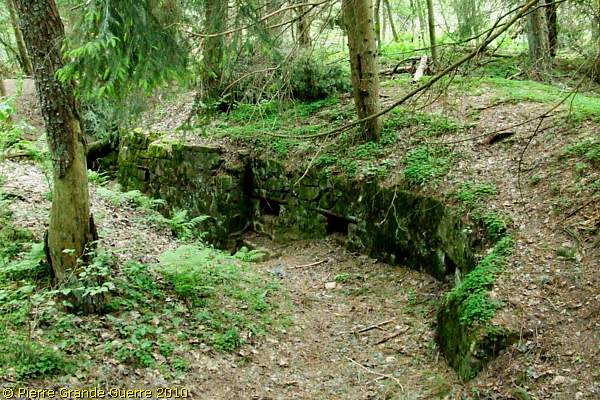
From the Schratzmännele and the Lingekopf we continue our explorations of the Linge-front sector to visit the relics of the Kleinkopf, Glasborn, la Courtine, and the Barrenkopf. We will finish at the summit of the Kleinkopf.

With a view at the Schratzmännele, we depart from the Collet du Linge southward.
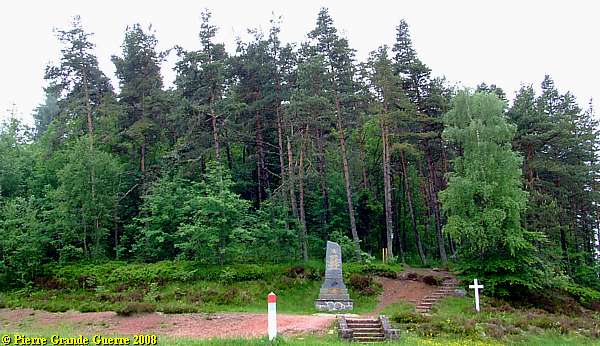
At the cairns at the junction of the Baerenstall in front of the Hohrod German War Cemeterywe turn right, ...
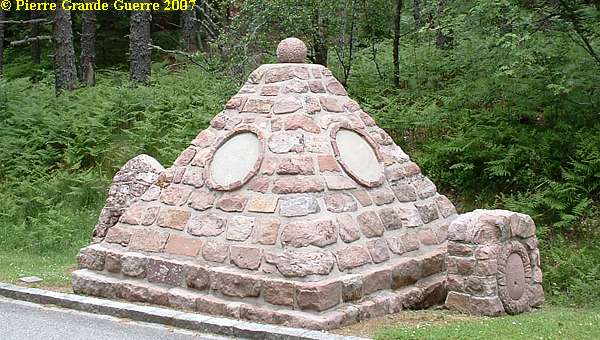
... and follow the D 5 B1 southward. (On the next page we will go left and visit a.o. the Hohrodberg Cemetery.)
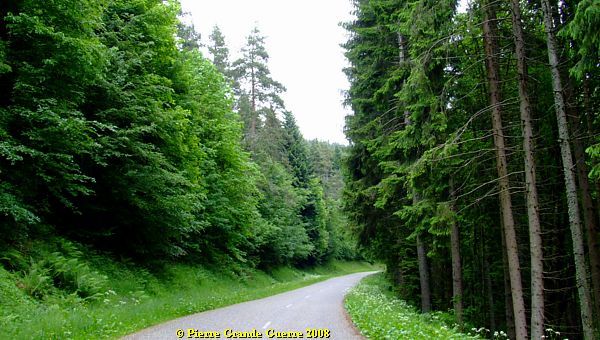
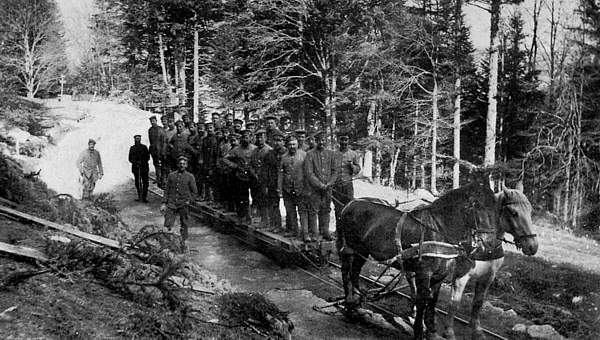
If you pass this fountain on the west side of the road, ...
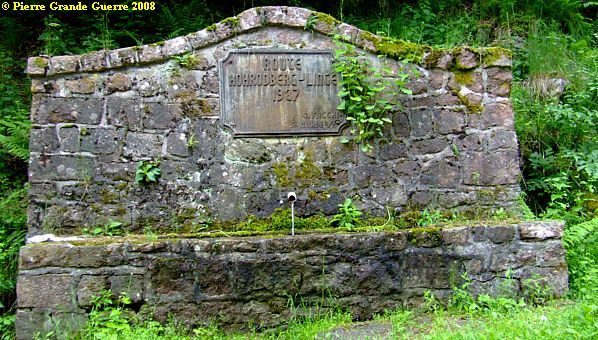
... you are only some 100 meters away from this rather hardly visible bunker in a slope of the Kleinkopf.

Some 300 meters further on, after a curve, we park our car at the northern plateau of the Hohrodberg.
The Kleinkopf - Barrenkopf Hiking Route

There are different hiking routes over the former Linge Front. This time we choose for our Yellow route
, a walk starting at the foot of the Kleinkopf with a German machine-gun bunker. Via No Man's Land we will enter the lines of the Chasseurs Alpins, at the Glasborn, and la Courtine. At la Courtine we cross the narrow No Man's Land to visit the German positions at the Barrenkopf and the Kleinkopf. We will finish at the summit of the Kleinkopf.
We start with this German forward machine-gun bunker.
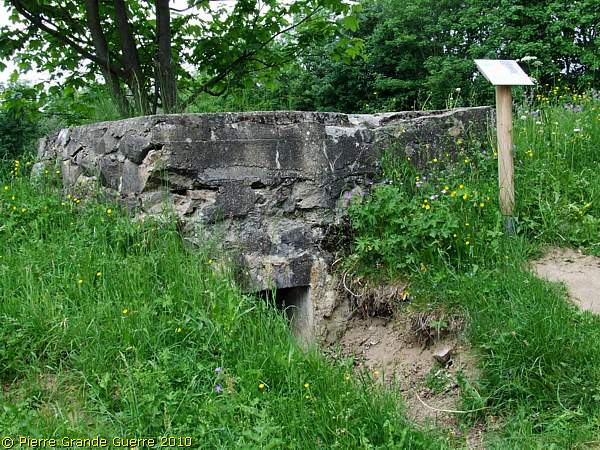
It stands at the foot of the Kleinkopf, guarding the road and the French positions, some 150 m. to the west.
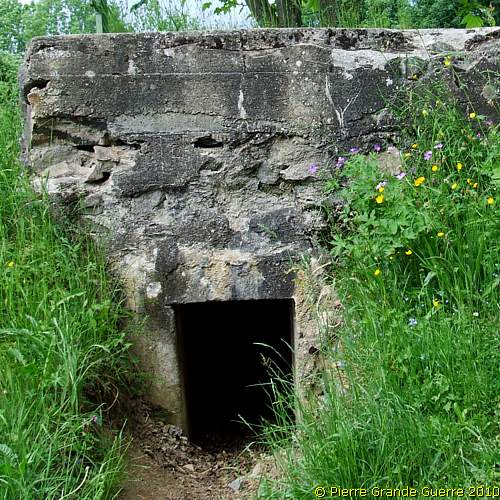
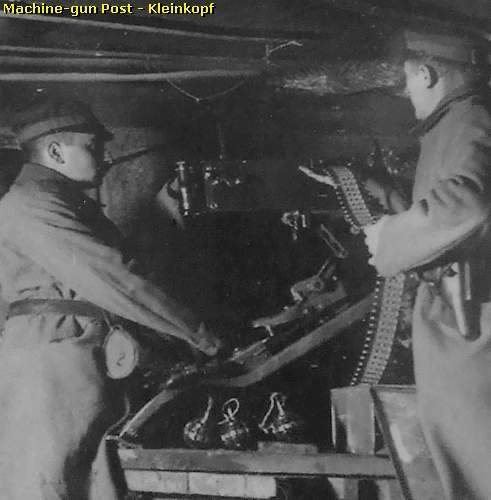
From the machine-gun bunker we continue westward, ...
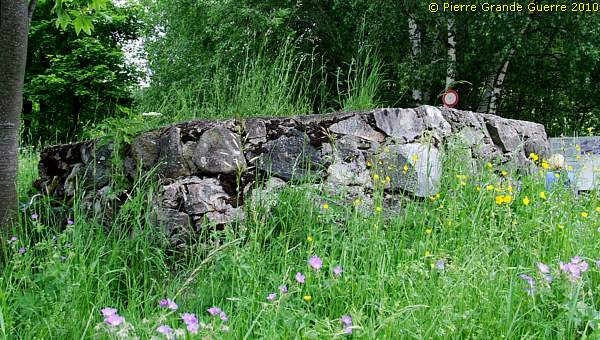
... to country road along No Man's Land. View south-westward at the Reichackerkopf , the Sattelkopf, the Petit-Honeck and the Schlucht.
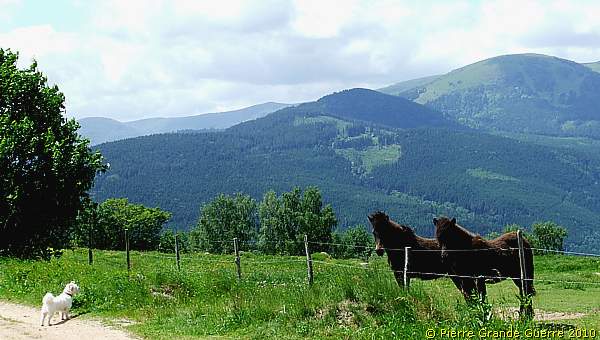
We continue northward enjoying this panorama westward at the ridges of the Vosges Mountains..

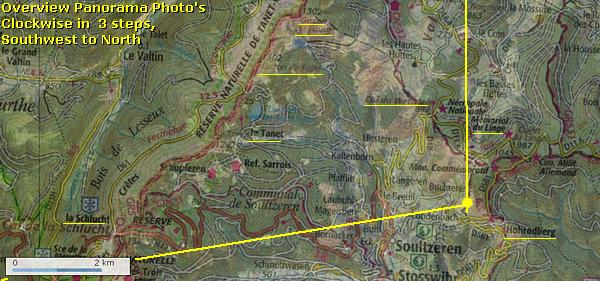
The French lines were here, on this western slope of the Kleinkopf, below the country road.
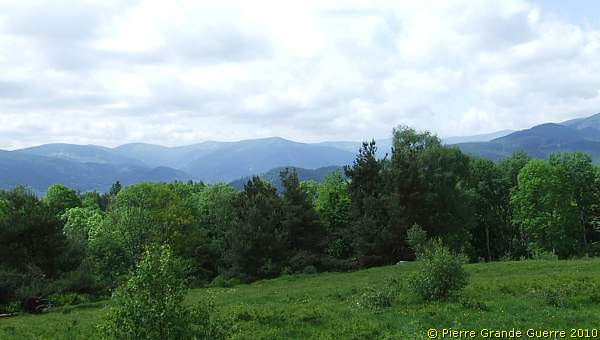
View at the former 1871-1918, Franco-German border: le Hohneck , le Tanet , le Gazon de Faite, and le Gazon du Faing.

View northwestward: le Hurlin, the Wettstein, and the Glasborn.
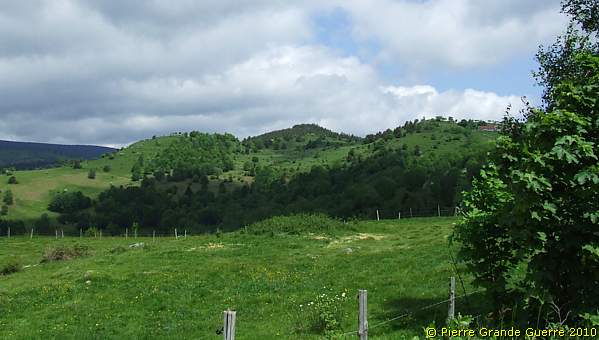
Before we continue our walk some background information. (If you arrive from the pages about the Lingekopf,
you may skip this frame below.)
The Battles of the Linge 1915 - Collet du Linge, Schratzmännele, Lingekopf, Barrenkopf, and Kleinkopf
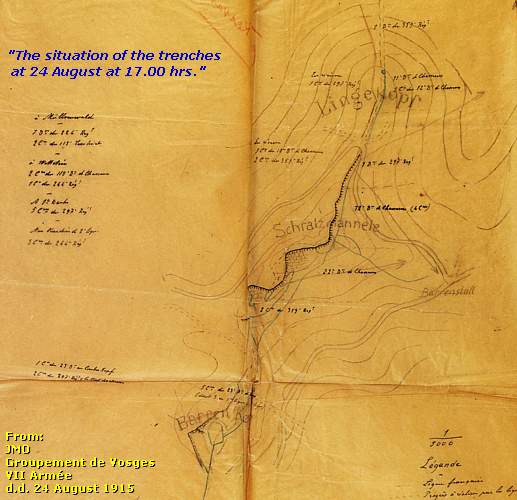
On 26 March 1915 General
D'Armau De Pouydraguin takes over the command of the 47th Infantry
Division from General Blazer. While the combats continue all along the
Vosges, General De Maud'huy, in command of the VIIth Army, added an
additional division for his planned offensive at Le Linge: the 66th
Infantry Division.
Before the offensive of Le Linge of 15 June 1915, the 47th and 66th
D.I. began an offensive at Metzeral
.
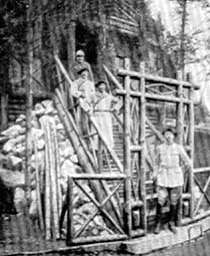
During one week, the French troops did progress some 5 kilometres. General de Pouydraguin suggested to continue the operations through the valley of Munster. But Joffre’s “Grand Quartier Général” ordered to stop the offensive through the valley. Joffre preferred the tactic of massed waves of attacks over the summits.
15 June 1915 - 70e B.C.A. raids the Lingekopf
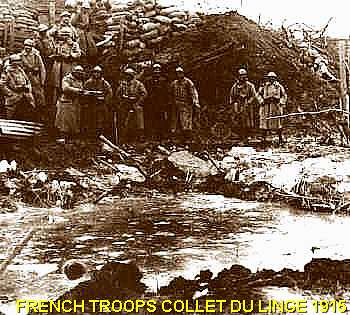
On 8 April 1915, the headquarters of the 47th D.I. had been informed of the considerable strength of the German fortifications of the Bavarian Landwehr Infanterie Regiment 1 on the ridges of the Lingekopf.
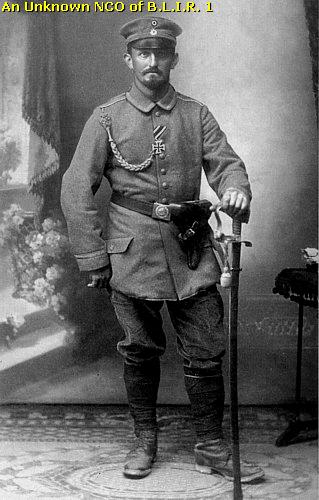
During three months the 3e Brigade des Chasseurs, reinforced by two companies of the 59e Régiment d'Infanterie Territoriale, digged on their side of the line their trenches and constructed their fortifications.
On 15 June 1915 a patrol of the 70th B.C.A. (70e Bataillon Chasseurs Alpins) tried a raid on the Crête, the ridge of the Collet, meeting fierce German resistance.

On 20 June 1915, being on the alert, the German troops bombarded the French positions, strengthening their own defences. De Pouydraguyn‘s 47th Division, made a second attempt to attack the Munster valley. The lines of Le Linge were confided to a new and young division, the 129th Infantry Division of General Nollet, consisting mostly of young soldiers of around 20 years old.
20 July 1915
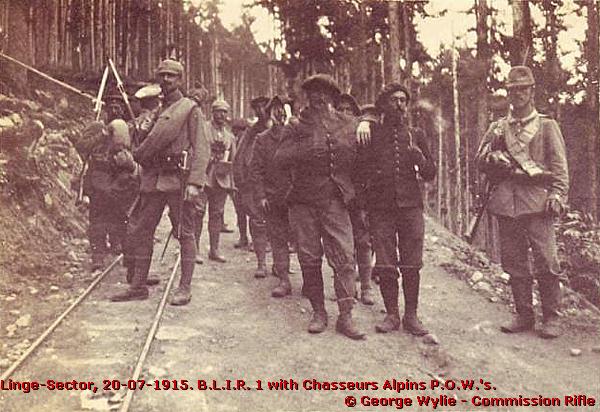
On 20 July 1915 General Nollet's 129th D.I. attacked the Collet du Linge, the Schratzmännele, the Lingekopf, the Barrenkopf, and the Kleinkopf. The 14e and 54e BCA under command of Major Reynies attacked the Lingekopf. The 30e and 70e BCA attacked Schratzmännele and la Courtine near the Barrenkopf. The next day the French troops were ordered to withdraw to their original positions.
22 July 1915
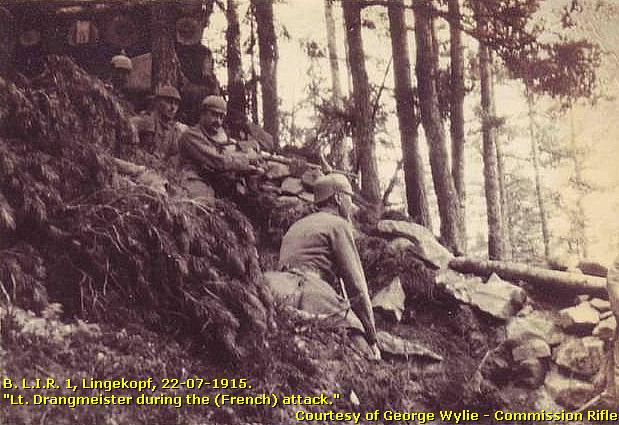
On 22 July the French launched another attack with 14e , 30e BCA, and two companies of the 70e BCA. The attack failed because of an ill functioning artillery.
26 July 1915
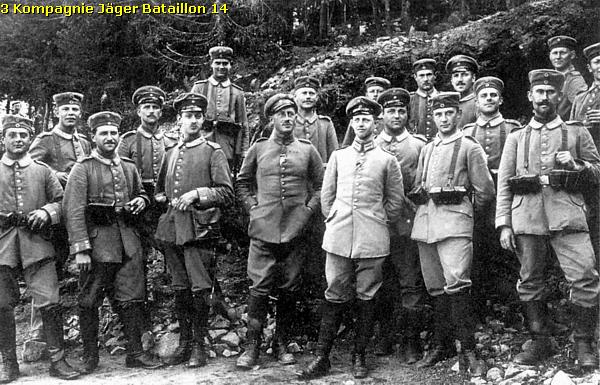
The 26th was a day of haze, rain, and mud. This time the preliminary bombardment was successful. The French battalions of Chasseurs Alpins, the 14e and the 30e BCA, attacked at 18.00 hrs. The 30e BCA captured the ridge of Lingekopf, including the German 2nd line (out of 3), with very many losses! The 14e BCA occupied the Collet ("small pass") du Linge. Three attacks of German troops at the Collet were pushed back during the night, and until noon of the 27th.
During the night and the next day fresh reinforcements arrived, consisting of German elite units of the Jäger Bataillon 14 and the Garde Schutzen Bataillon.
27-31 July 1915

In the beginning of the afternoon of 27 July the French attacked the Schratzmännele and the Barrenkopf. The 15e Bataillon Chasseurs à Pied (BCP) occupied only temporarily the Barrenkopf. Though both sides suffered that day heavy losses, the Chasseurs made that day some 280 "rifles" prisoner of war.
On 29 July the French attack restarts at 15.30 hrs.. The 5e BCP attacked the Schratmännele from the Collet du Linge without success. The 120e BCP and the 11e BCA attacked at la Courtine near the Barrenkopf. The 11e BCA knew to reach the machine-gun post at the Barrenkopf. At 30 July the Germans launched an artillery bombardment, which would not prevent the French to launch another attack at the Schratzmännele 2 days later.
August - September 1915
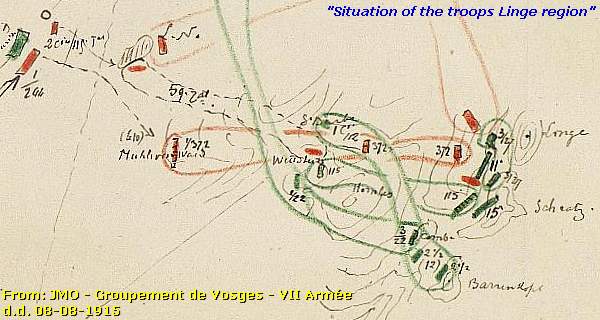
From 1 August until 30 August
1915 several French attempts were done to conquer the top of the
Schratzmännele. In particular the first five days of August were filled
with bombardments, intense infantry attacks and counter-attacks.
On 4 August 1915 the Germans launched a huge artillery bombardment,
using gas shells, and some 40.000 shells on a front of 3 km long from
the Lingekopf to the Kleinkopf. On the same day the 5e BCP lost his
commander, Commandant (Major) Barberot.
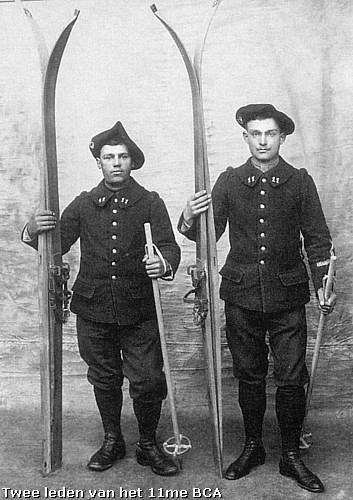
On 18 August the battles intensified again. The 11e BCA conquered the Fort Lingekopf on the summit, but lost it again several hours later. The 27e BCA knew to reach the ridge of the Schratzmännele and to consolidate their positions.
On 22 August the 22e BCA captured the central bunker on the Schratz. The 23e BCA attacked again the bunkers at the Barrenkopf and occupied it for a few hours until a German nightly counter-attack forced them to retreat to la Courtine. Until the 24th there were attacks and counter-attacks from both sides. During these days the ridges of Le Linge changed many times of possession.
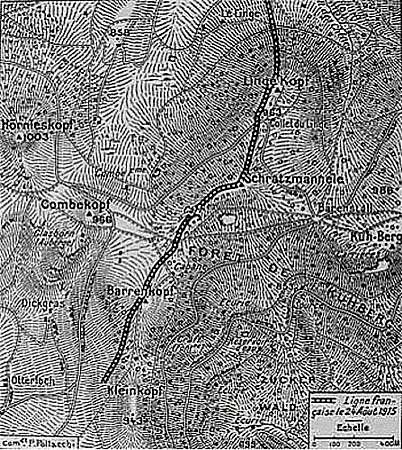
On the 24th of August the French stopped their offensive. The 129th D.I. of General Nollet had been relieved by the 47th D.I. of General de Pouydraguin. De Pouydraguin inspected his French lines: a distorted battle front, zig-zagging, unprotected, below remarkably well organized German fortifications.

On 31 August at 4:00 AM the Germans bombarded again with gas shells. At 5:00 PM of the same day Bavarian infantry assaults followed. The French counterattacks resulted in occupying a part of the lost ground. The fights continued until 9 September. On 9 September 1915 there were new German attacks with gas and flame-throwers. The French counter-attacks failed.

October 1915
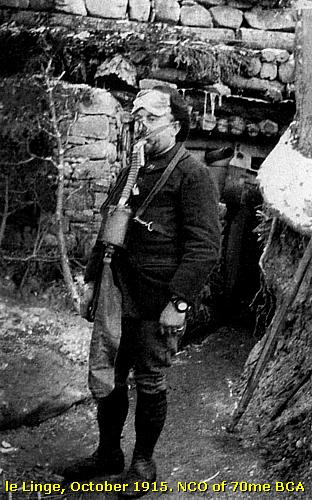
Until 12 October the Germans tried to conquer the Schratzmännele, but for the time being the French kept them of this summit. On 12 October 1915 the Germans launched again an attack at the Collet du Linge and the Schratzmännele with flame-projectors. At 3: 00 AM of the 13th, 2 French battalions deployed a new counterattack, which failed. It would be the last French attack along this front sector.
In the end the French lost the summits of the Lingekopf, the Schratzmännele, and the Barrenkopf. On 16 October 1915 the Germans attacked the French in their original lines for the last time. But the French knew to force them to withdraw to their original German 1st lines, as it has been preserved in the situation of nowadays.
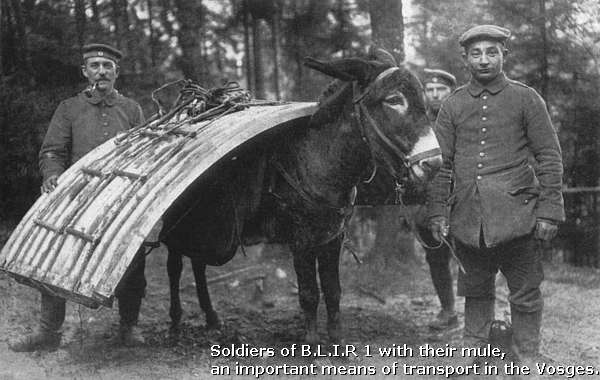
From this view I turn around, ...

... facing the summit of the Kleinkopf and the German lines on the slope.

Along the edge of the wood runs a trench into the direction of the Hohrodberg.
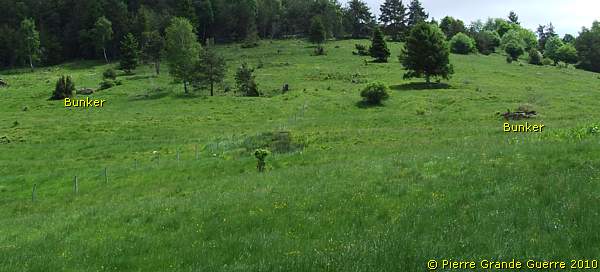
The left machine-gun bunker.

Traces of a trench and the right machine-gun bunker.
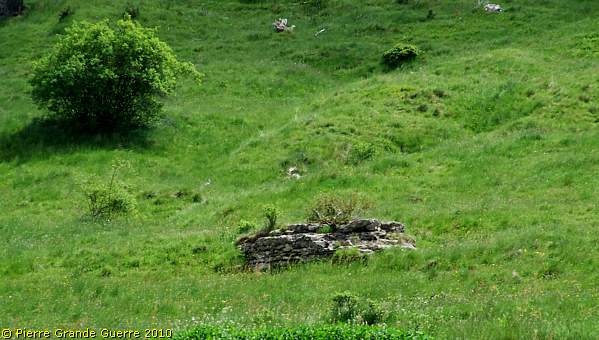
These bunkers were advanced posts of the German trench lines in the wood at the Kleinkopf.
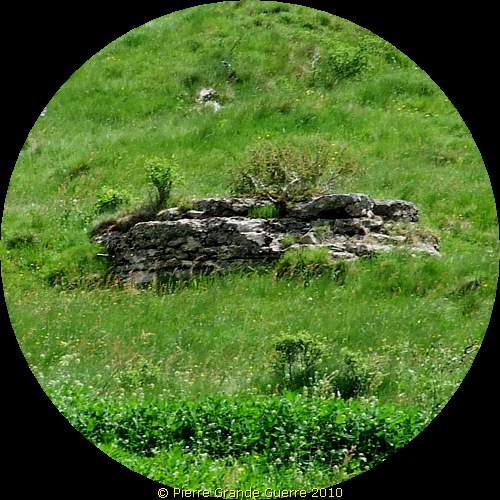
With this view westward we continue northward to a point, ...
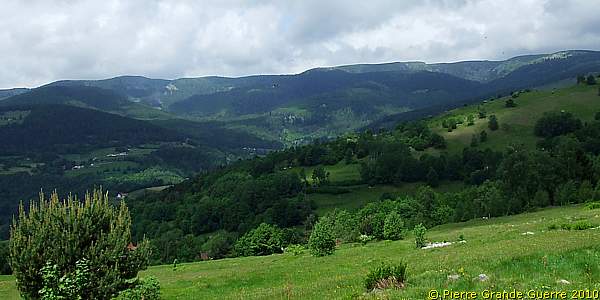
... where the country road changes in a sunken track ...
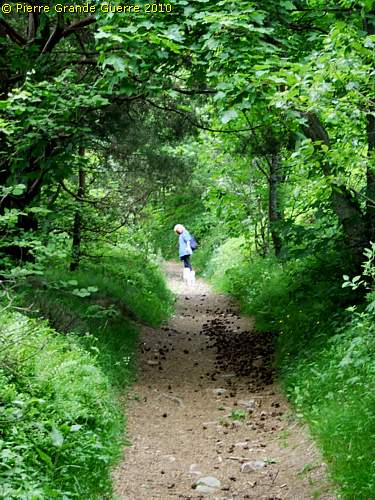
... below the slope halfway the Barrenkopf and the Kleinkopf.
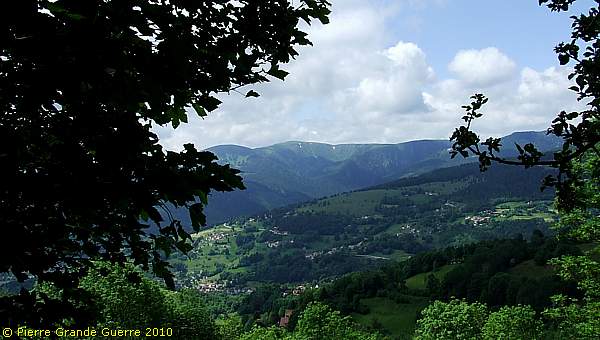
This track used to be the first French Line, and it was close to and below the German positions.
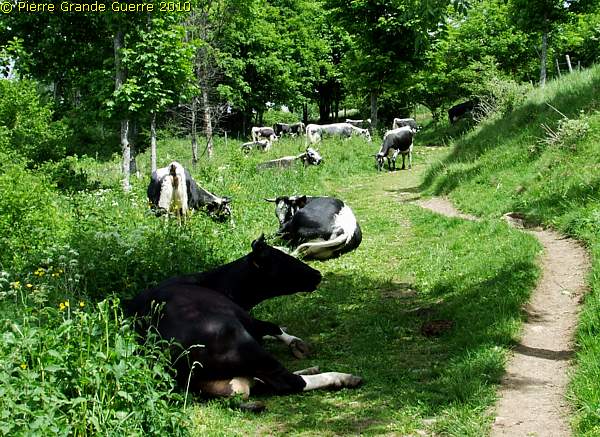
A teleview at le Tanet.
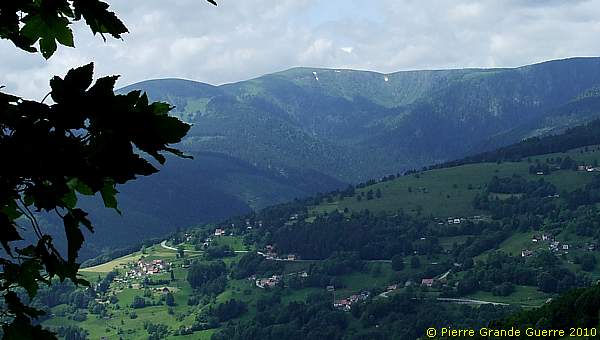
Passing this horse and the "Ferme Auberge Glasborn", ...
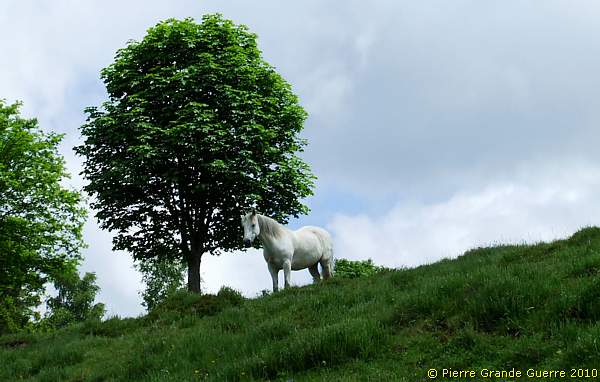
... we arrive at the height of le Glasborn.
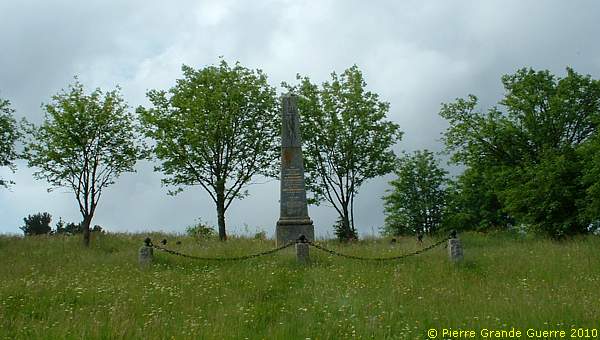
In October 1914 French Chasseurs and Fantassins occupied the Wettstein, the Hurlin, the Glasborn, and the west slopes of the Schratzmännele and the Lingekopf.
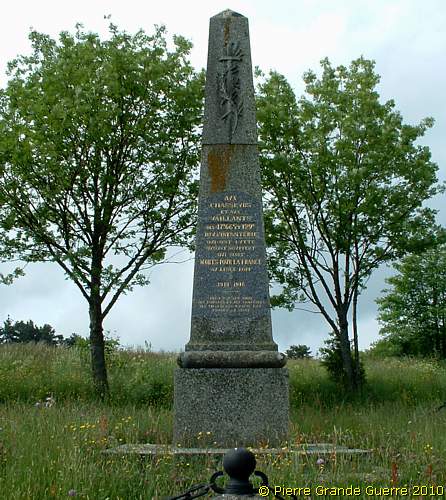
Panorama view northward from the Chasseurs Memorial.


View at les-Basses-Huttes. Left; the Wettstein.
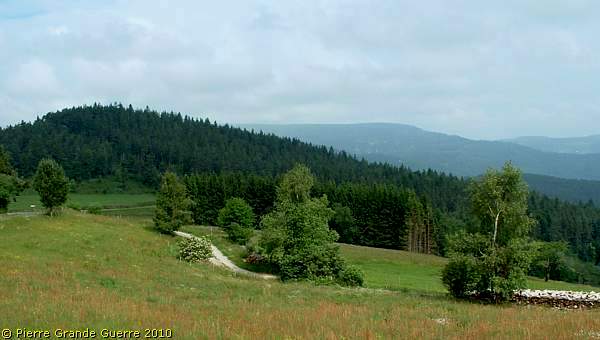
Right: slopes of the Rain de Chênes.
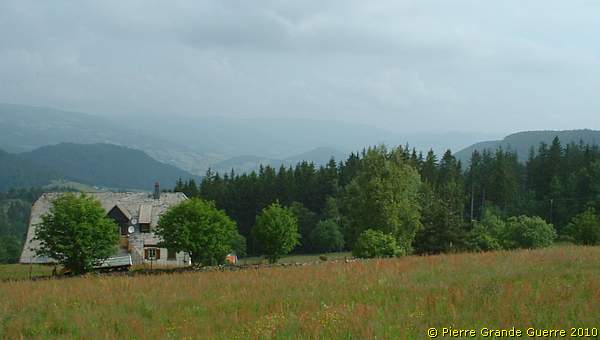
From the Chasseurs Memorial we walk eastward, ...
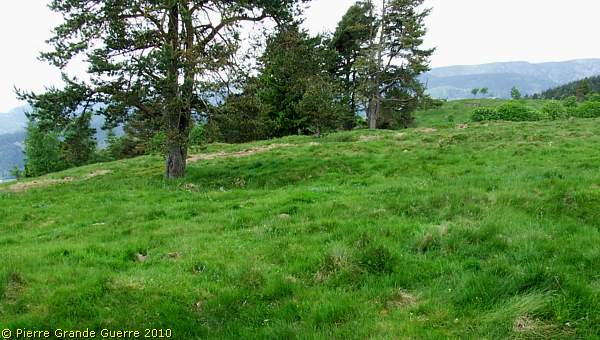
... over the prairie, la Courtine, east of the Ferme Auberge Glasborn.

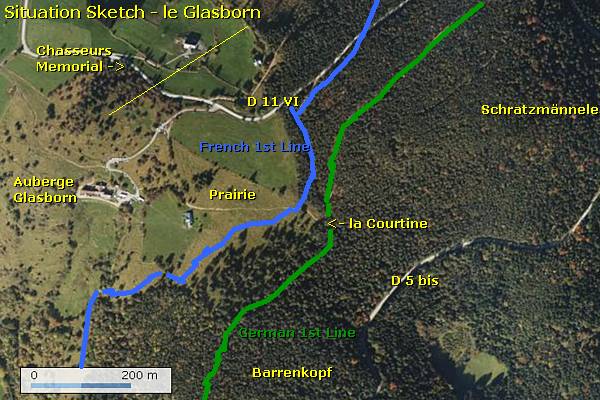
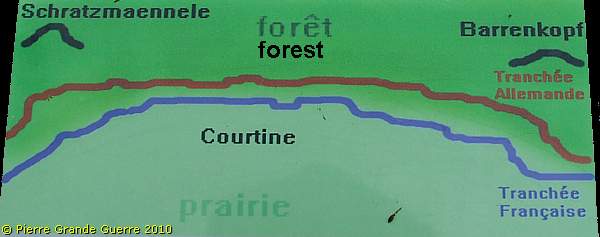

Passing some unidentifiable, concrete objects in the field, ...
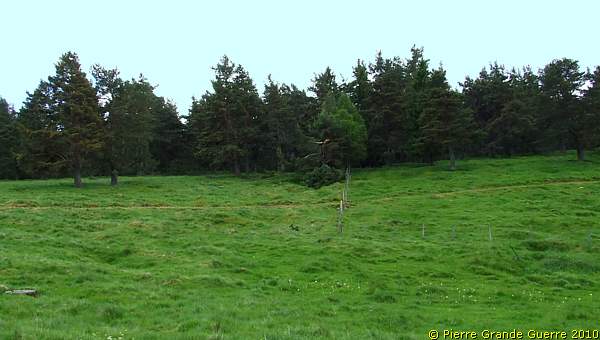
... possibly French air shafts to underground shelters, ...
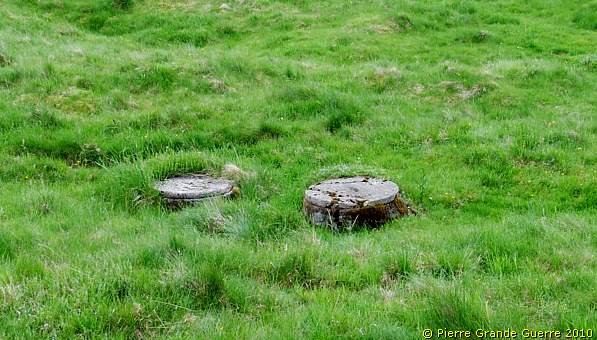
... we have arrived at the location of the French lines. The German lines were running in the wood, close to the edge. We detect a lot of shell holes.
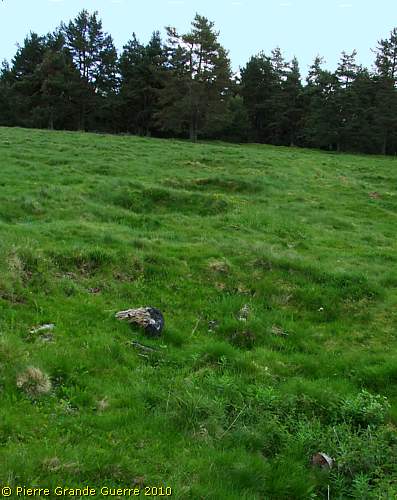
View north-westward from the prairie. Left: traces of Chasseurs trenches.

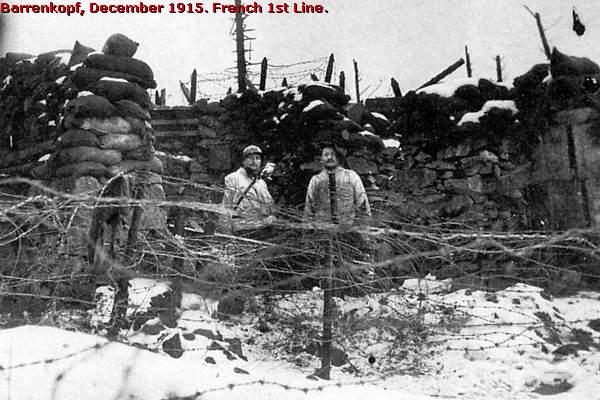
View nort-eastward. We are now amidst the traces of the Chasseurs' first trench line, ...
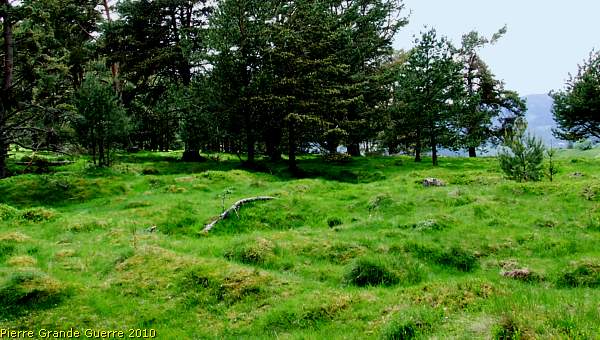
... covered with shell holes.
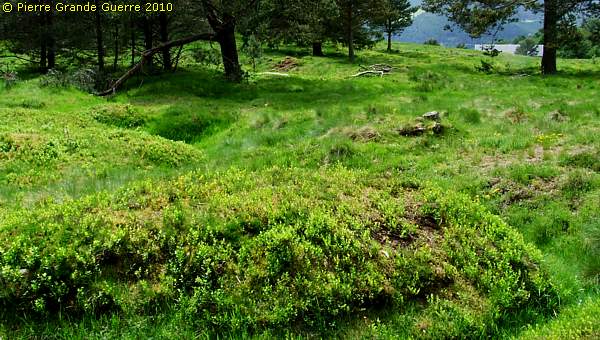
The strip along the edge of the wood near this spot, called la Courtine, formed the rather narrow No Man's Land.
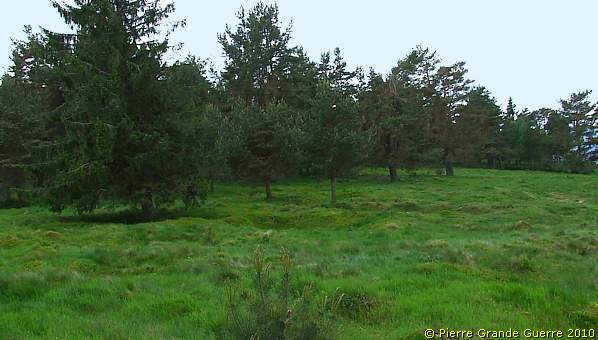
At the edge of the wood a sign tells us:
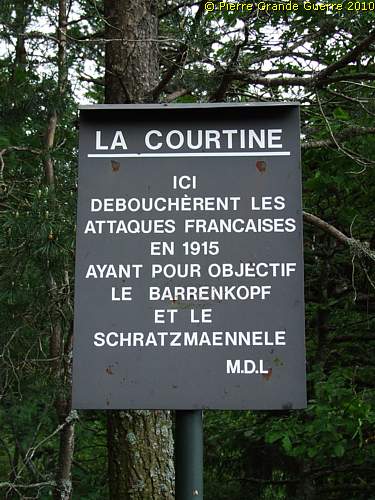
Below the sign lies a concrete block with war relics, found scattered around on this location.
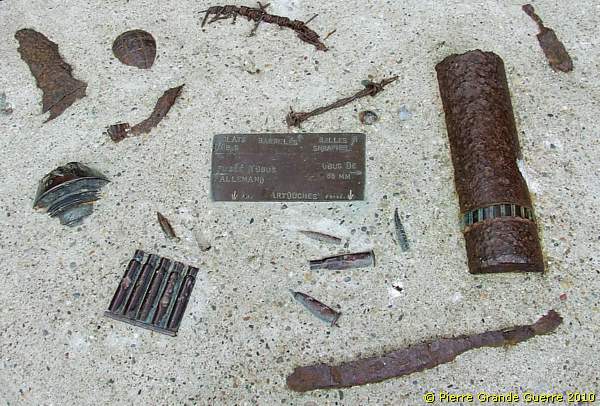
During the war this location was covered with barbed wire entanglements. The No Man's Land here is only some 15-20 m. wide.

Behind the edge of the wood (photo above left), ...
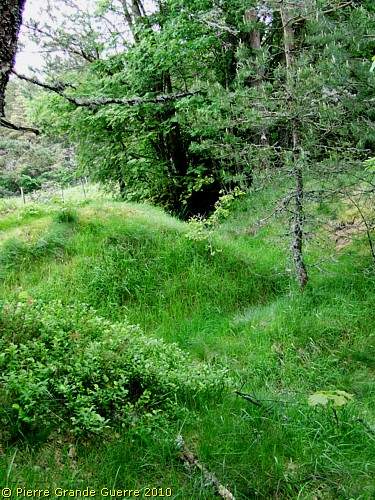
... we see traces of the German 1st line. Through the wood we continue east ward to arrive at , ...
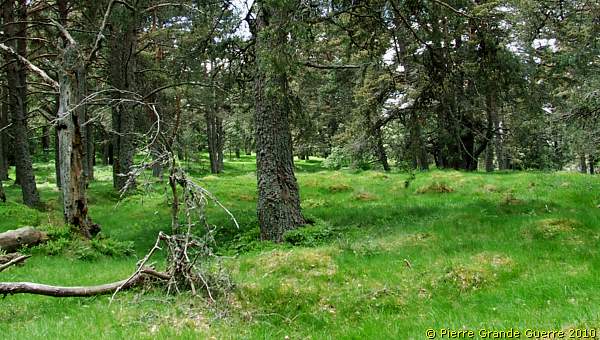
... a relatively less vegetated open spot near the summit of the Barrenkopf.
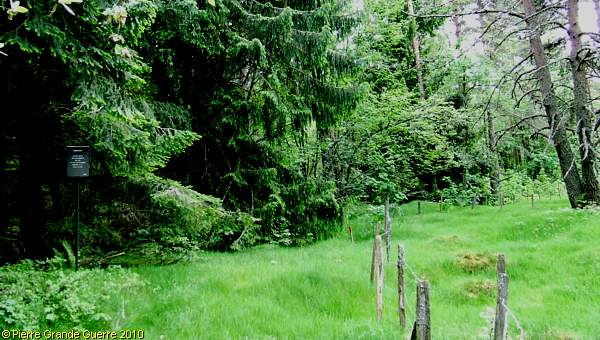
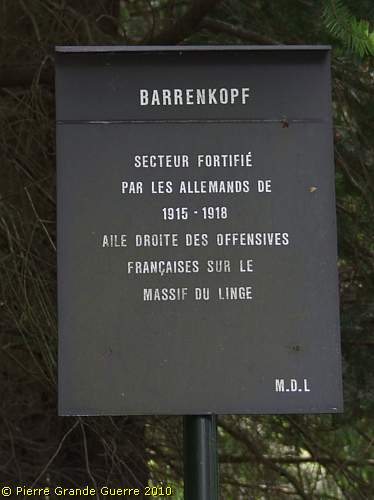
Following this 2nd line trench, the slope becomes steeper, and the wood more densely vegetated.
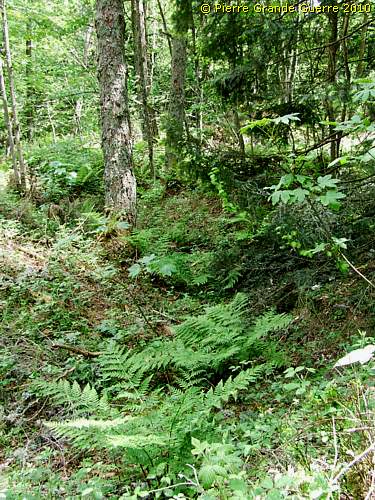
A 2nd line bunker, a dug-out entrance.
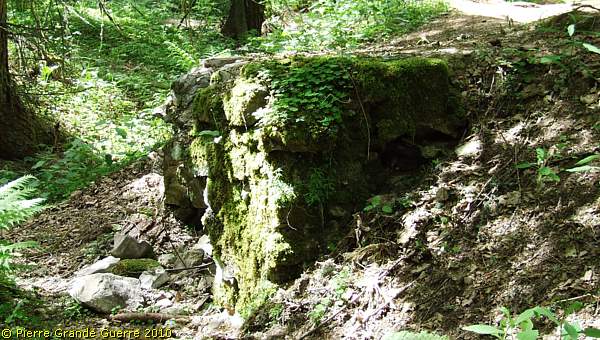
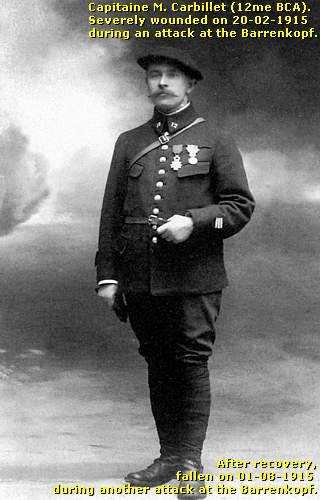
In the dense vegetation, knowing there has been a network of trenches here, ...
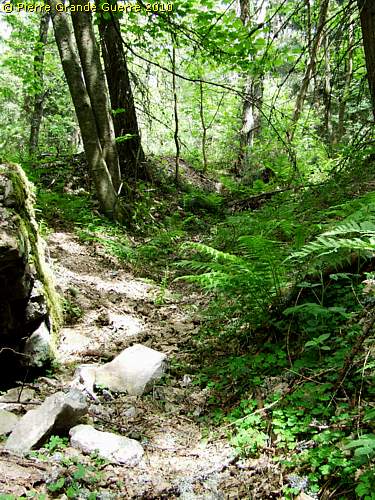
... it is hard to orientate myself.
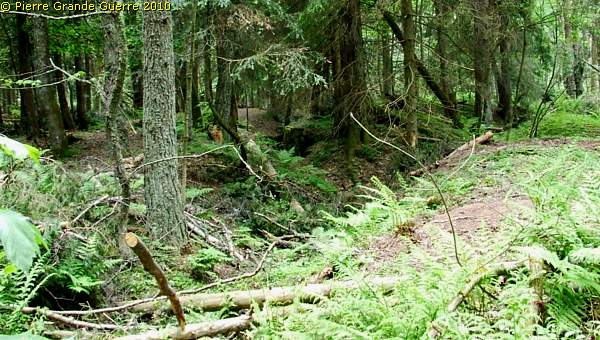
From the second line we walk some meters up- and westward ...
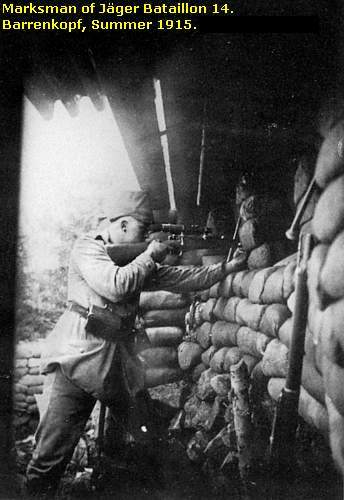
... to the third line, which also is close to the summit of the Barrenkopf.
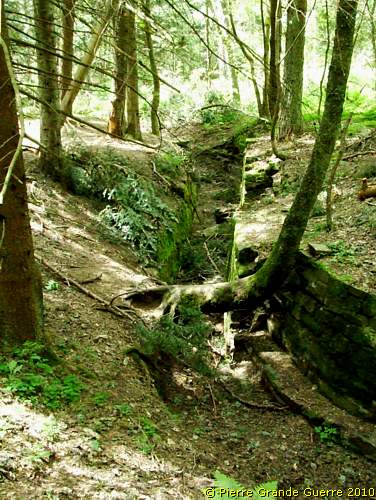
Here we find a short, rather well preserved track of a German masonry trench.

In the trench are niches for storing shells and ammunition.
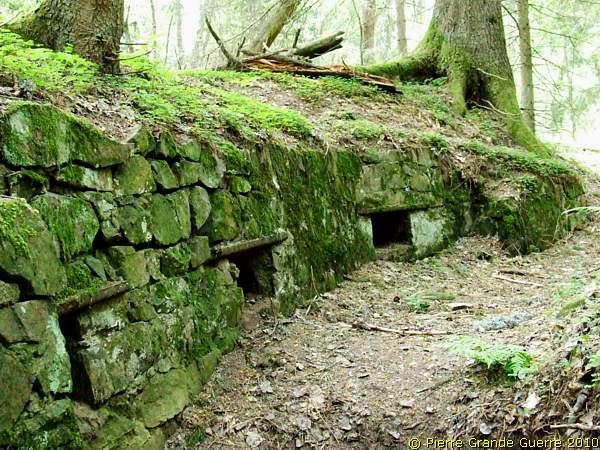
We follow the trench around the curve.
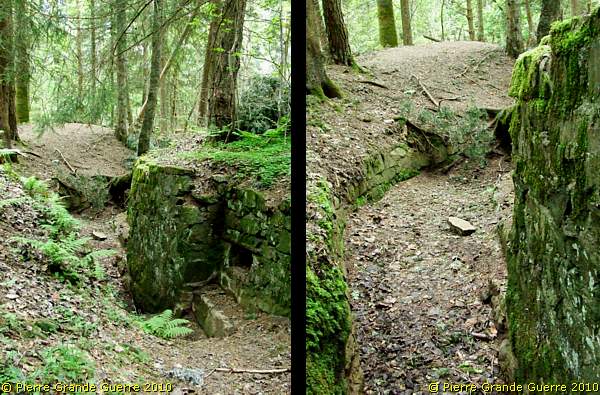
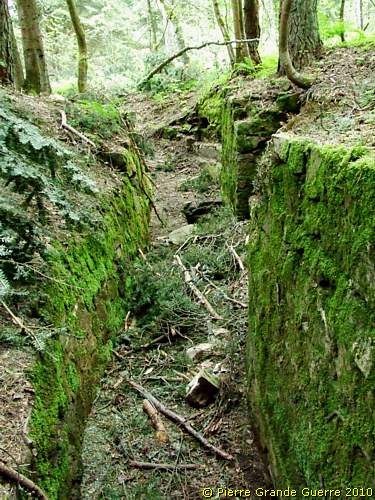
Due to the battle circumstances this 1915 trench ...

... has of course been improved and better fortified until 1918.
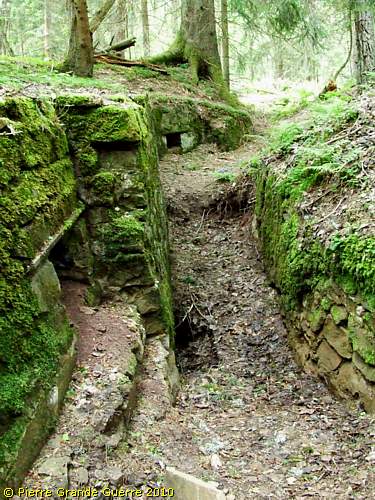
As always we see the trenches without sandbags, barbed wire, ...
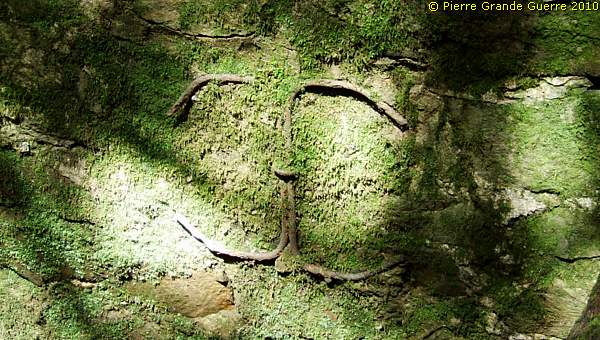
... and in the state as the trenches were left in 1918.

Concrete steps to facilitate the soldiers to go over the top.
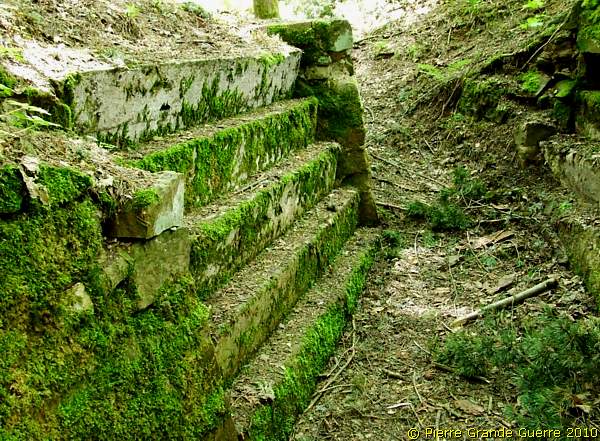

The entrance to a dug-out.
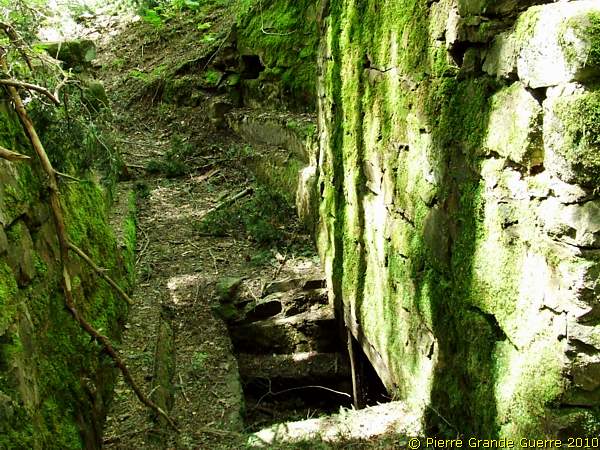
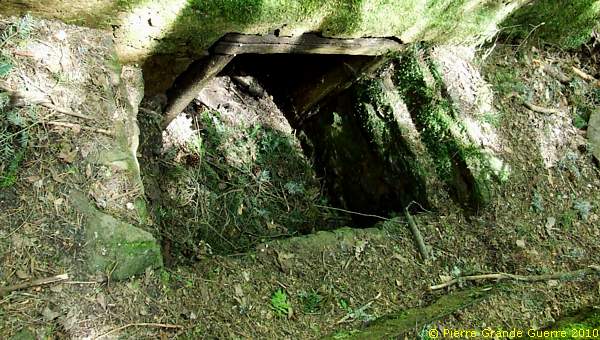
The tunnel looks unstable and it is partly filled in. Remark the good condition of the wooden wallcoverings.
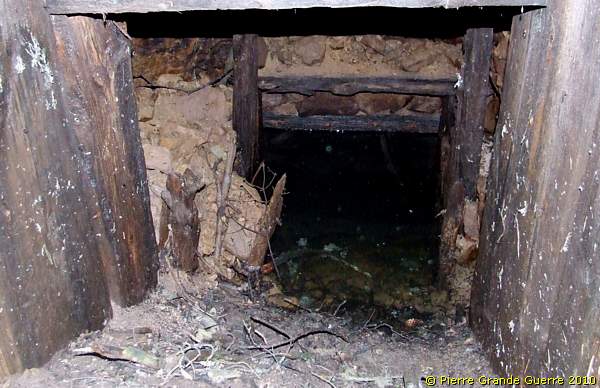
With this last view at this track of trench, ...
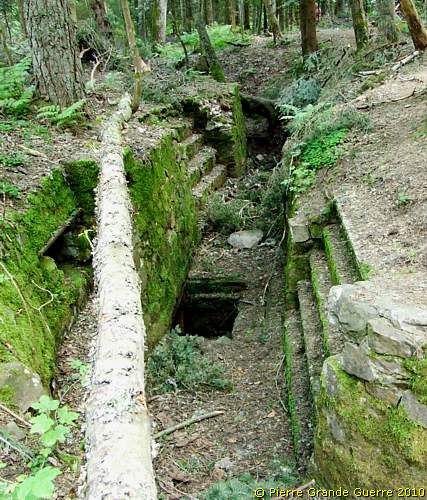
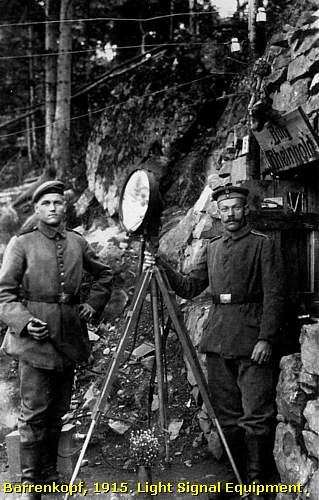
... we climb only a few meters to this double machine-gun bunker at the summit of the Barrenkopf (981 m.).
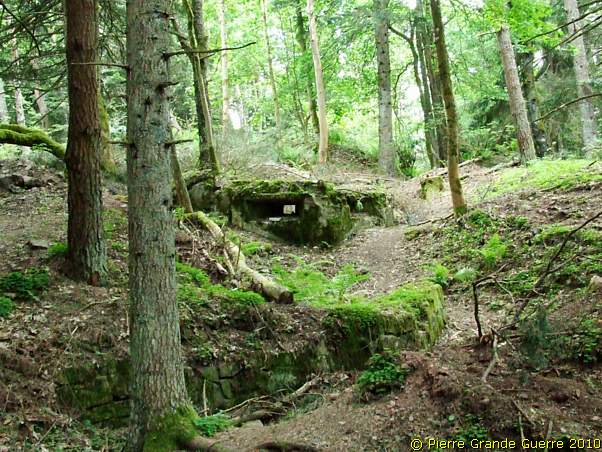
In the French war journals this bunker is notorious for spreading it's murderous fire. This position here and this bunker formed many times the main target of the French attacks.
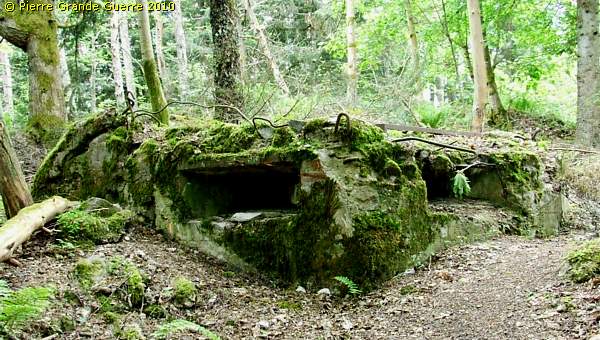
Next to the bunker: an uncovered concrete observation post.
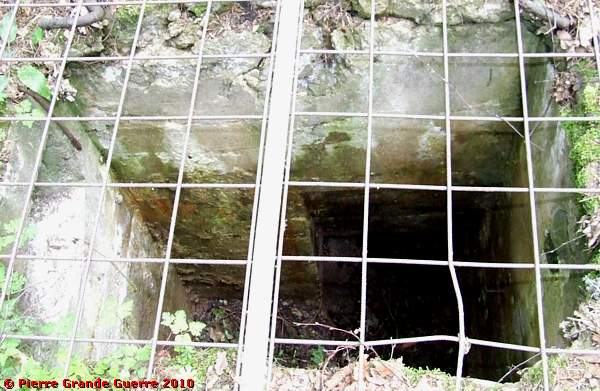
Only the periscope binoculars of the observer would emerge.
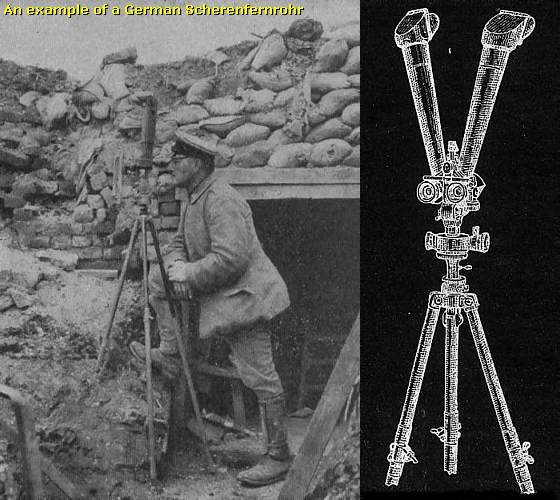
We continue southward to find some 40 m. further ...
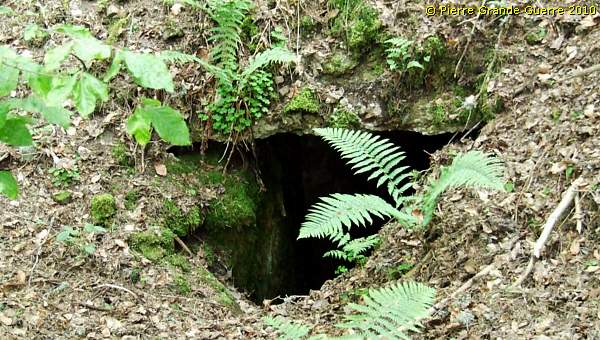
... this shelter bunker.
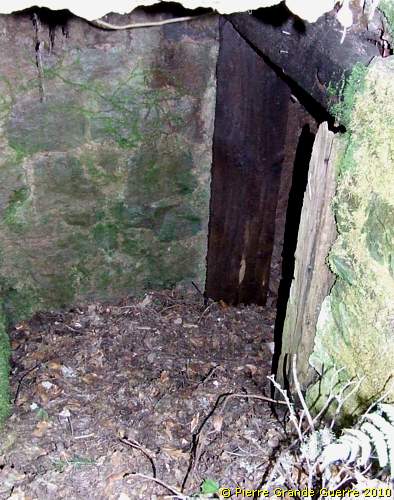
The top construction received a fatal impact.
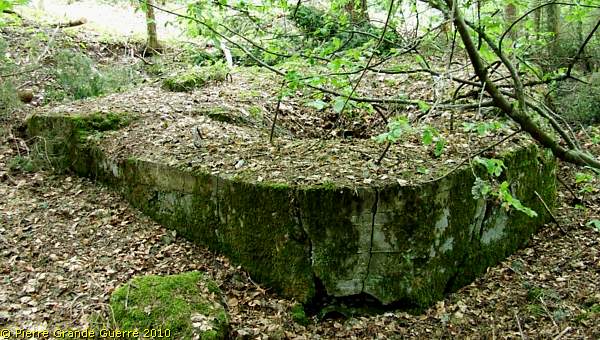
One of the relics that lay around; a French shell.
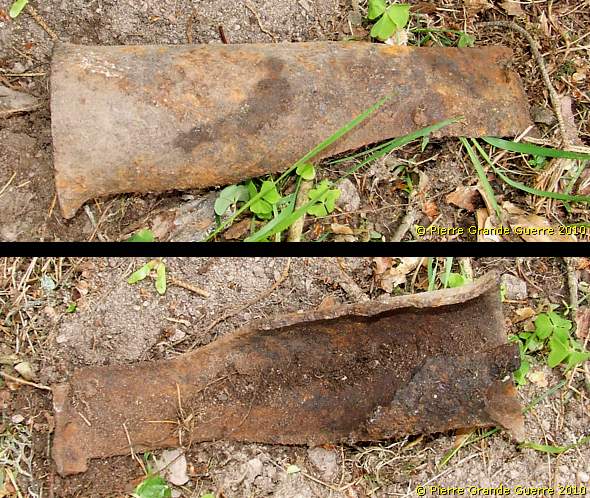
We walk southward along the east slope of the ridge to the Kleinkopf.

Halfway between the summit of the Barrenkopf and the Kleinkopf, ...
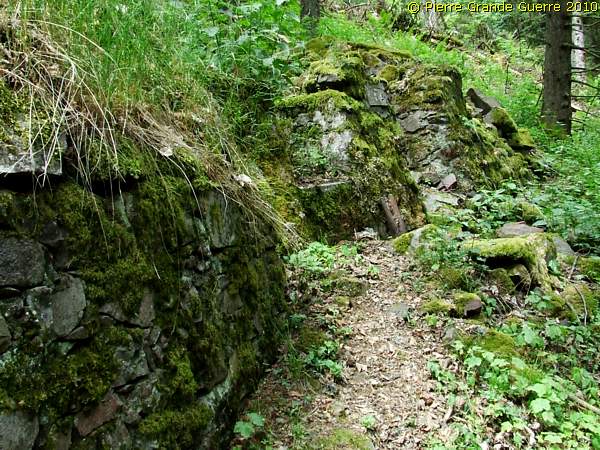
... we pass a complex of two bunkers on a steep slope below us.
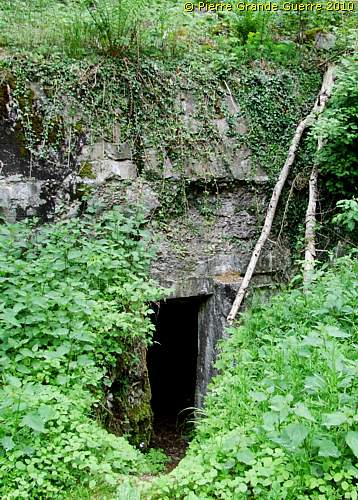
Via a narrow track along the steep slope, ...
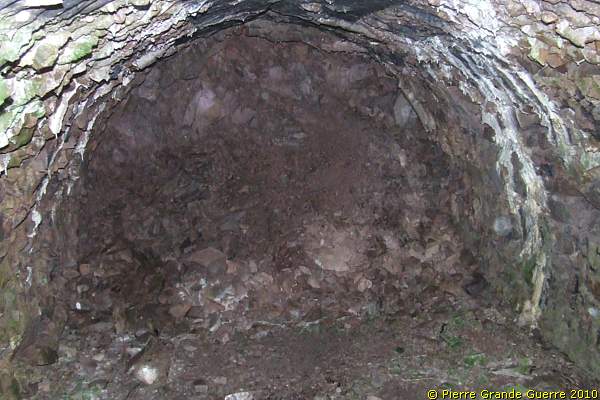
... we climb down and we are able to visit these bunkers.
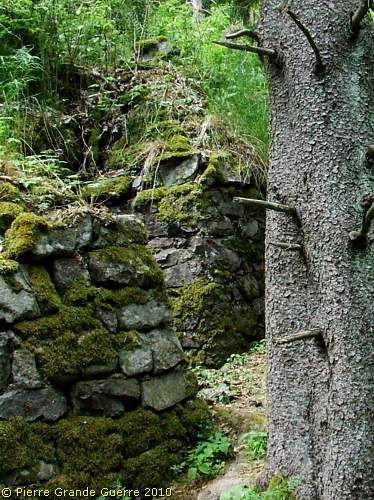
In the bunker walls are entrances to two dug-outs inside the mountain.

As we see; outside 1915 masonry, fortified indoors with 1916 concrete.
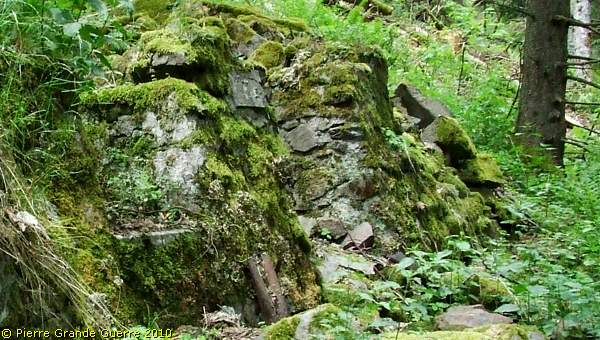
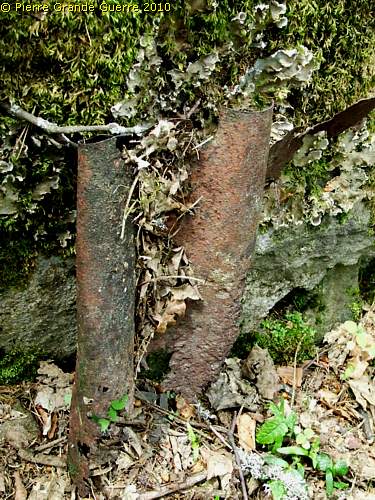
Alas the inscription "Constructed by" is nowadays unreadable.

These 3rd line bunkers were used as stocks of materials and ammunitions.
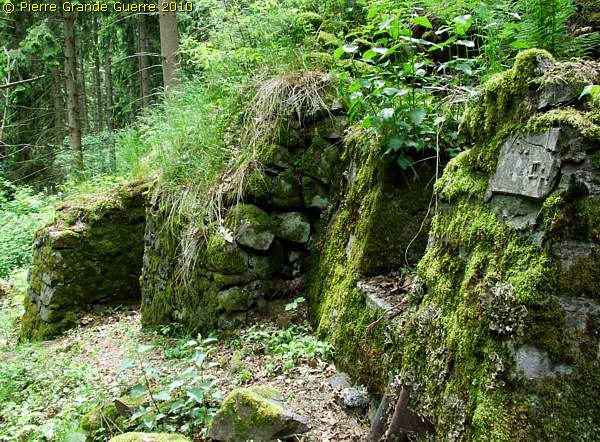
These bunkers belonged to the arrival station ...
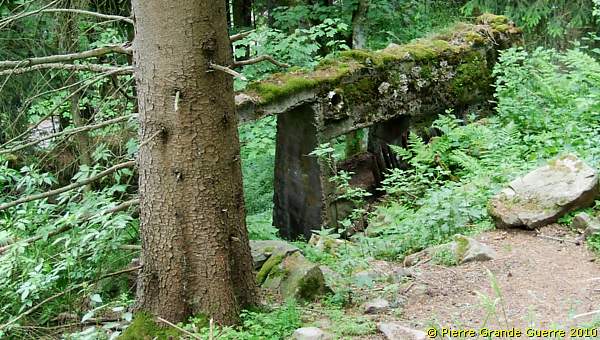
... of a "Rollbahn"- cable car railway, constructed at the end of 1917.
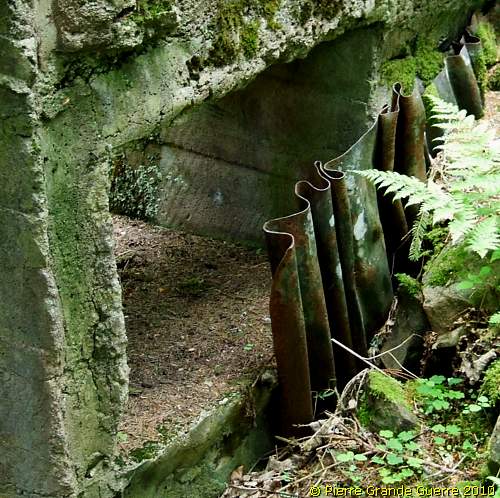
The window in the front wall guards the D5 bis-road below us.

The 60 cm. cable-car railway started at the Hohrodberg, passing the junction at the Baerenstall to transport construction parts and heavy materials to the Barrenkopf-sector.
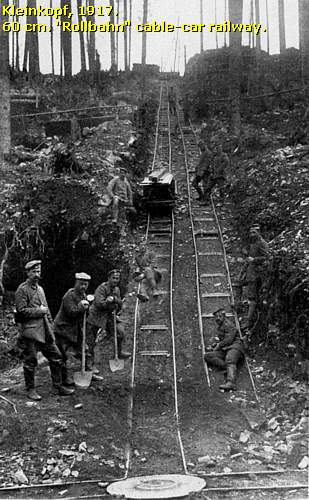
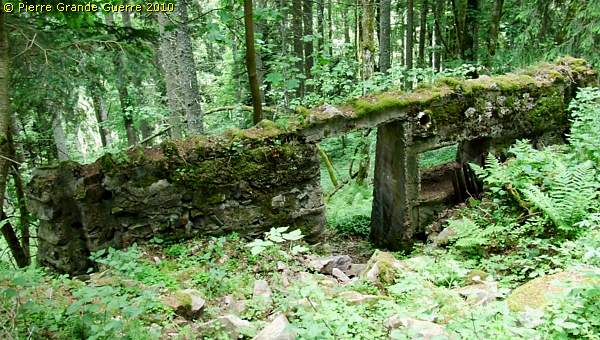
We return upward to the ridge, and we continue 100 m. southward. Not more than 50m. away from the summit of the Kleinkopf we pass other dug-out entrances.
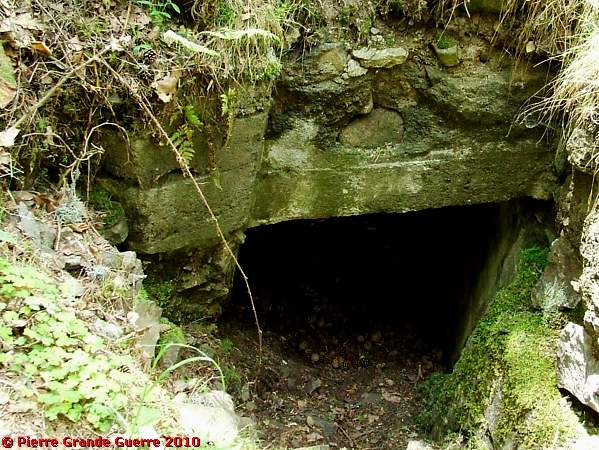
Near the summit: 4 fox-holes form 4 dug-out entrances.
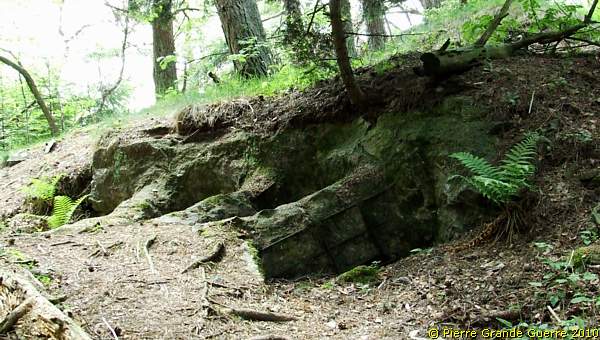
Only a slim man could enter between these concrete beams.
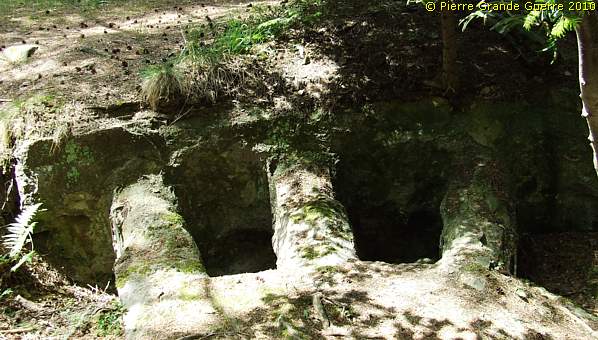
One of the 4 filled in, with concrete fortfified entrances.
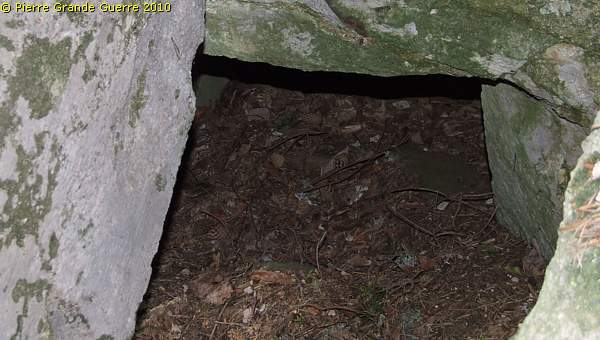
We descend the slope following the trace of trench.
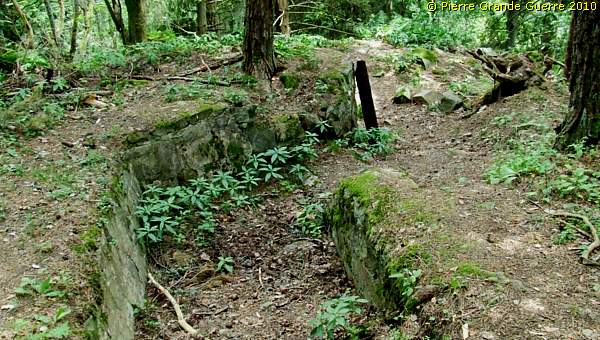
This man-made platform may have been used ...
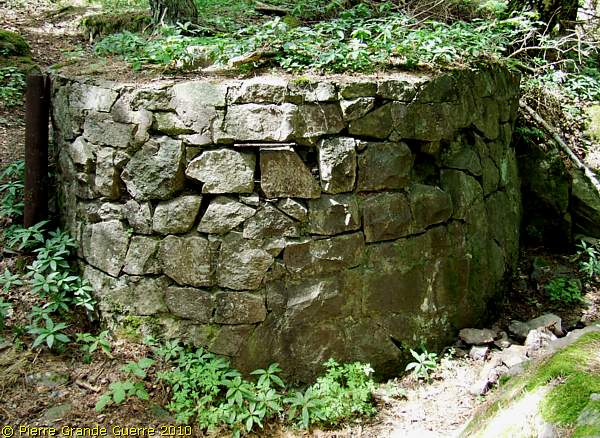
... for a light signal equipment, a "Blinkstelle".
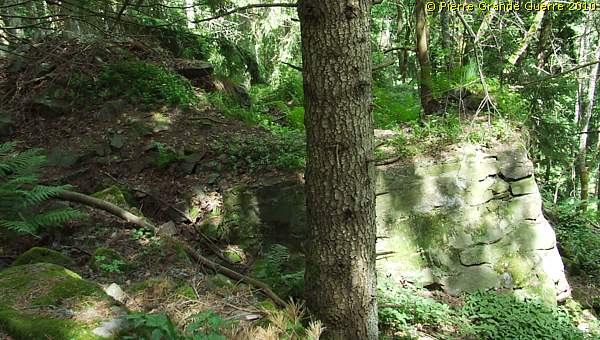
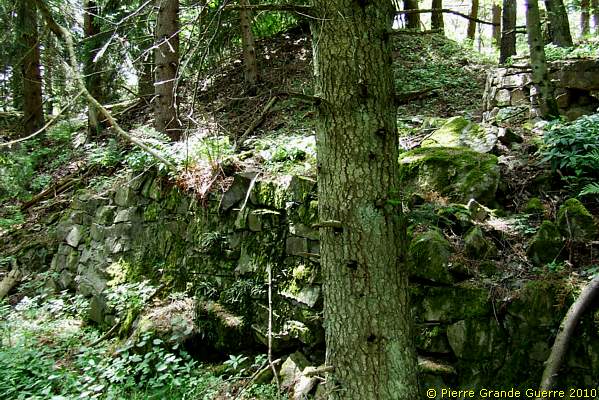
On top of it a machine-gun bunker facing the road below.
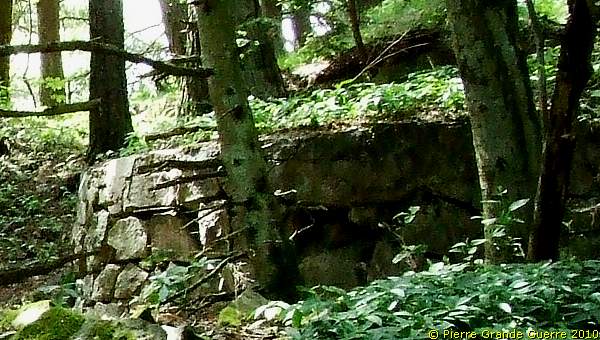
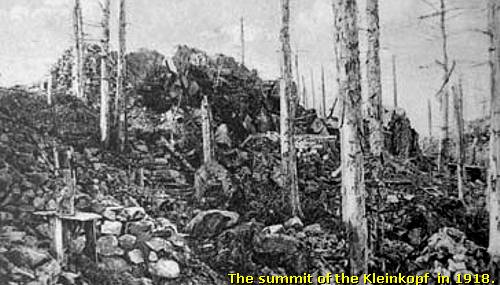
In the relic of a trench we are climbing to our final goal: the summit of the Kleinkopf (940 m.), ...

... which also still offers this beautiful view westward at the Vosges Ridges.
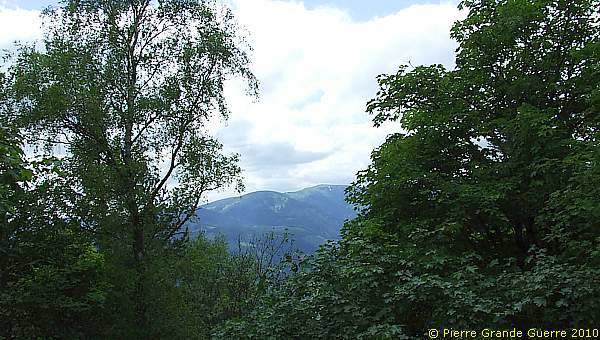

We descend to the D 5 bis-road, passing on foot this bunker again, ...

... to return to our point of departure at the first German machine-gun bunker of our tour.

On the next page we return to the junction of the Baerenstall, to visit the Hohrod German War Cemetery and more German bunkers on our way to les-Trois Epis, to return later for the magnificent panorama from the Hohrodberg over the Munster valley.
Continue to the next chapter: " Hohrodberg - Grand Hohnack - Giragoutte - Les Trois Epis "










